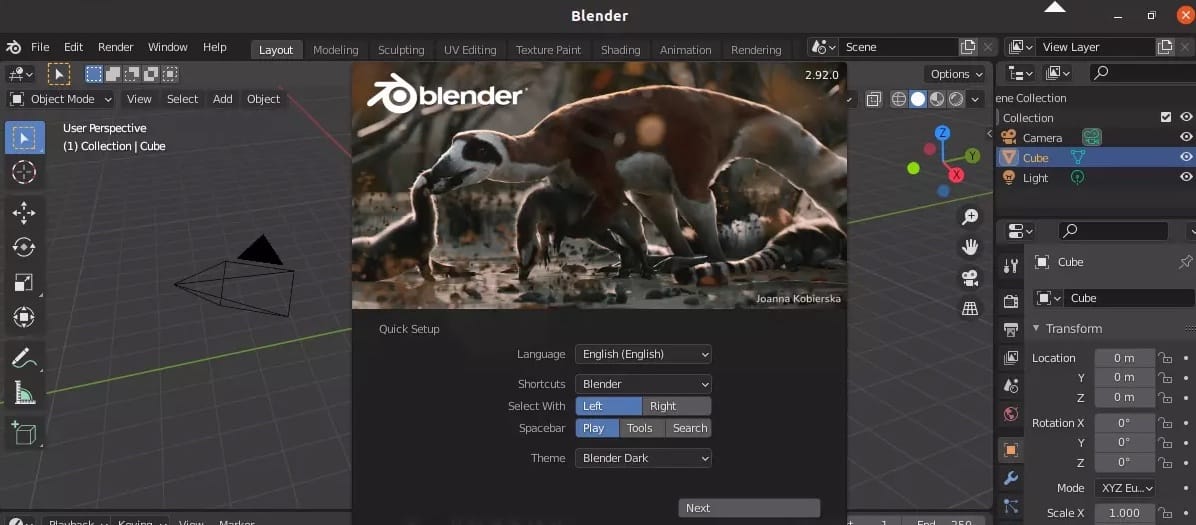How To Install Blender on Fedora 39

In this tutorial, we will show you how to install Blender on Fedora 39. Blender is a powerful, open-source 3D modeling and animation software that has gained popularity among artists, designers, and enthusiasts worldwide. With its extensive set of tools and features, Blender enables users to create stunning visual effects, 3D models, and animations.
This article assumes you have at least basic knowledge of Linux, know how to use the shell, and most importantly, you host your site on your own VPS. The installation is quite simple and assumes you are running in the root account, if not you may need to add ‘sudo‘ to the commands to get root privileges. I will show you the step-by-step installation of the Blender 3D modeling on a Fedora 39.
Prerequisites
Before diving into the installation process, let’s ensure that you have everything you need:
- A server running one of the following operating systems: Fedora 39.
- It’s recommended that you use a fresh OS install to prevent any potential issues.
- You will need access to the terminal to execute commands. Fedora 39 provides the Terminal application for this purpose. It can be found in your Applications menu.
- A network connection or internet access to download the Blender package.
- A non-root sudo user or access to the root user. We recommend acting as a non-root sudo user, however, as you can harm your system if you’re not careful when acting as the root.
Install Blender on Fedora 39
Step 1. To ensure a smooth installation process, make sure your Fedora 39 system is up to date. Open the terminal and run the following command:
sudo dnf clean all sudo dnf update
This command will update your system packages to their latest versions, including any necessary dependencies for Blender.
Step 2. Installing Blender on Fedora 39.
- Method 1: Installing Blender using Fedora Repositories
The simplest and most straightforward way to install Blender on Fedora 39 is by using the official Fedora repositories. This method ensures a seamless integration with your system and provides easy access to updates. To install Blender using Fedora repositories, follow these steps:
sudo dnf install blender
Once the installation is complete, you can launch Blender from the applications menu or by typing blender in the terminal.
- Method 2: Installing Blender from the Official Website
If you prefer to have the latest stable version of Blender, downloading it directly from the official Blender website is a great option. This method allows you to access the most recent features and improvements. To install Blender from the official website, follow these steps:
First, go to the download page select the Linux option, and choose the appropriate version for your system (64-bit or 32-bit):
https://mirror.freedif.org/blender/release/Blender4.1/blender-4.1.0-linux-x64.tar.xz
Extract the downloaded archive using the following command:
tar -xvf blender-4.1.0-linux-x64.tar.xz
Move the extracted directory to a location of your choice, such as /opt/ or /usr/local/. For example:
sudo mv blender-*-linux-*/ /opt/blender
To create a desktop shortcut for convenience, create a new file named blender.desktop in the /usr/share/applications/ directory:
sudo nano /usr/share/applications/blender.desktop
Add the following content to the file:
[Desktop Entry] Name=Blender Comment=3D modeling, animation, and rendering software Exec=/opt/blender/blender Icon=/opt/blender/blender.svg Terminal=false Type=Application Categories=Graphics;3DGraphics;
Save and close the file, you can now launch Blender from the applications menu or by running /opt/blender/blender in the terminal.
- Method 3: Installing Blender using Snap Packages
Snap is a universal package management system that allows you to install and run applications in a sandboxed environment. Blender is available as a Snap package, providing an alternative installation method. To install Blender using Snap, follow these steps:
sudo dnf install snapd
Once Snapd is installed, enable the Snap support by running:
sudo ln -s /var/lib/snapd/snap /snap
Install the Blender Snap package by executing the following command:
sudo snap install blender --classic
After the installation is complete, you can launch Blender from the applications menu or by running blender in the terminal.

Step 3. Troubleshooting Common Issues.
While installing and using Blender on Fedora 39, you may encounter some common issues. Here are a few troubleshooting tips to help you resolve them:
- Missing Dependencies: If you encounter errors related to missing dependencies during the installation process, ensure that you have all the required packages installed. Double-check the installation instructions and install any missing dependencies using the appropriate package manager command.
- Graphics Driver Issues: If you experience display problems or crashes related to graphics, make sure you have the latest graphics drivers installed for your system. Visit the website of your graphics card manufacturer (NVIDIA, AMD, or Intel) and download the appropriate drivers for your Fedora 39 system.
- Snap Package Startup Problems: If you installed Blender using Snap and encounter startup issues, try running Blender from the terminal using the snap run blender command. If the issue persists, you may need to report it to the Snap package maintainer or consider using an alternative installation method.
Congratulations! You have successfully installed Blender. Thanks for using this tutorial for installing the Blender 3D modeling on your Fedora 39 system. For additional or useful information, we recommend you check the official Blender website.